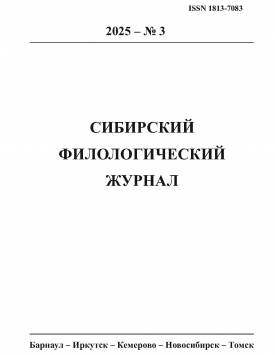Expression of intensification in Russian Sign Language
The paper describes the ways of expressing intensification in Russian Sign Language. The study methodology involves direct elicitation and analysis of data from the Russian Sign Language corpus. The findings indicate that Russian Sign Language uses diverse methods to express intensification. Regarding adjectives, intensity can be indicated through variations in signs parameters, including movement and configuration. Both adjectives and verbs can be intensified through two-handed reduplication. Also, non-manual markers play a crucial role, with common combinations including closed eyes, furrowed brows, an open mouth, or raised brows paired with an open mouth, often accompanied by head position changes. Additional non-manual intensifiers include puffed cheeks and the mouth gesture “af.” Lexical intensifiers are also used, such as OCHEN” (VERY), PSIKH (CRAZY), and SIL”NO (STRONG), the latter likely loaned from spoken Russian and used predominantly by hard-of-hearing signers. OCHEN” and PSIKH are applied to different type predicates and seem to differ stylistically. Notably, Russian Sign Language employs similar strategies for both intensification and narrative foregrounding, such as increased movement amplitude. While Russian Sign Language shares intensity-marking features with other sign languages (e.g., non-manual markers and parameter modulation), it diverges sharply from spoken languages as it relies not on affixation but on non-manual cues absent in oral communication.
Keywords
Russian Sign Language,
intensification,
non-manual markers,
sign modificationAuthors
| Filimonova Elizaveta V. | Institute of Linguistics of the Russian Academy of Sciences | ev.filimonova@list.ru |
Всего: 1
References
Беликов В. И. Жестовые системы коммуникации // Семиотика и информатика. М., 1983. Вып. 20. С. 127-148.
Буркова С. И. Корпус русского жестового языка [Электронный ресурс] / Рук. проекта С. И. Буркова. Новосибирск, 2012-2015. URL: http://rsl.nstu.ru/ (дата обращения 10.05.2024).
Буркова С. И. Условные конструкции в русском жестовом языке // Русский жестовый язык: Первая лингвистическая конференция: Сб. ст. / Под ред. О. В. Федоровой. М.: Буки Веди, 2012. С. 50-81.
Введение в лингвистику жестовых языков. Русский жестовый язык: Учебник / [С. И. Буркова, В. И. Киммельман, Е. В. Филимонова и др.]; ред. С. И. Буркова, В. И. Киммельман. Новосибирск: Изд-во НГТУ, 2019. 354 с.
Буркова С. И., Филимонова Е. В. Редупликация в русском жестовом языке // Русский язык в научном освещении. 2014. № 2 (28). С. 202-258.
Кадысева С. С. Категория интенсивности в системе функционально-семантических, функционально-стилистических стилей категорий // Изв. Самар. науч. центра Рос. акад. наук. 2010. Т. 12, № 5. С. 196-199.
Кюсева М. В. Физические свойства в русском жестовом языке в типологическом освещении: Дис. … канд. филол. наук. М., 2018. 222 с.
Родионова С. Е. Семантика интенсивности и ее выражение в современном русском языке // Проблемы функциональной грамматики: полевые структуры / Отв. ред. А. В. Бондарко, С. А. Шубик. СПб.: Наука, 2005. С. 150-168.
Савичева Н. Х., Рахимова Э. Ф. Понятие семантической категории интенсивности и ее языковое выражение // Международный научно-исследовательский журнал. 2016. № 3 (45). С. 87-89.
Филимонова Е. В. Основная линия и фон в нарративах в русском жестовом языке: роль аспектуальности и акциональности // Компьютерная лингвистика и интеллектуальные технологии. По материалам ежегодной международной конференции "Диалог" (2023). Серия 22. М.: Изд-во МИИ, 2023. Т. 22. С. 69-78.
Филимонова Е. В. Средства выражения аттенуативной семантики в русском жестовом языке // Межкультурное пространство жестовых языков: перевод, коммуникация, исследования: Сб. науч. ст. III Междунар. науч.-практ. конф. М.: МГЛУ, 2024. С. 117-121.
Харитонова В. Д. Средства усиления в русском жестовом языке // Вестник Моск. гос. лингвист. ун-та. Гуманитарные науки. 2022. Вып. 2 (857). С. 142-148.
Шейгал Е. И. Интенсивность как компонент семантики слова в современном английском языке: Дис. … канд. филол. наук. М., 1981. 244 с.
Aksenov K. Gradable predicates in Russian Sign Language. Higher School of Economics. Working paper. Moscow, 2019. 19 p.
Aonuki Y. Adjective intensification in American Sign Language // Proceedings of Canadian Linguistics Association. Vancouver, 2019. URL: https://cla-acl.ca/pdfs/actes-2019/Aonuki-CLA-2019.pdf/.
Aronoff M., Meir I., Sandler W. The Paradox of Sign Language Morphology // Language. 2005. Vol. 81 (2). P. 301-344.
Branchini C., Mantovan L. (eds.). A grammar of Italian Sign Language (LIS). Venezia: Edizioni Ca' Foscari, 2020. 827 p.
Johnston T., Schembri A. Australian Sign Language (Auslan). An introduction to Sign Language Linguistics. Cambridge: Cambridge Uni. Press, 2007. 323 p.
Klima E., Bellugi U. The signs of language. Cambridge, MA; London: Harvard Uni. Press, 1979. 417 p.
Sandler W., Lillo-Martin D. Sign Language and Linguistic Universals. New York: Cambridge Uni. Press, 2006. 547 p.
Sojda S. The Intensifying Function of Reduplication in Contemporary Polish and Slovak // Journal of Linguistics / Jazykovedný casopis. 2023. No. 73 (2). P. 161-174.
Stokoe W. Sign Language Structure: An Outline of the Visual Communication Systems of the American Deaf. New York: Uni. of Buffalo, 1960. 78 p.
Sutton-Spence R., Woll B. The Linguistics of British Sign Language. Cambridge: Cambridge Uni. Press, 1999. 299 p.
Tomaszewski P., Farris M. Not by the Hands Alone: Functions of Non-Manual Features in Polish Sign Language // Studies in the Psychology of Language and Communication. Warszawa: Matrix, 2010. P. 289-320.
Wooden T. van der, Foolen A. A most serious and extraordinary problem. Intensification of adjectives in Dutch, German, and English // Leuvense Bijdragen. 2017. No. 101. P. 82-100.
Willbur R., Malaia E., Shay R. Degree modification and intensification in American Sign Language adjectives // Logic, Language and Meaning: 18th Amsterdam Colloquium. Amsterdam, 2012. P. 92-101.
Xavier A. N. Doubling of the number of hands as a resource for the expression of meaning intensification in Brazilian Sign Language (Libras) //Journal of Speech Sciences. 2013. No. 3 (1). P. 169-180.

